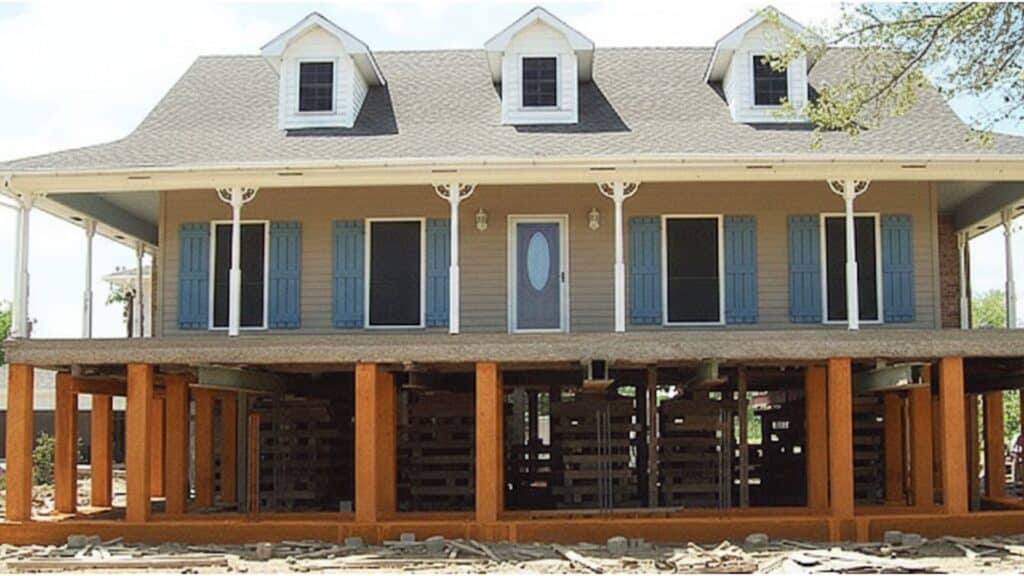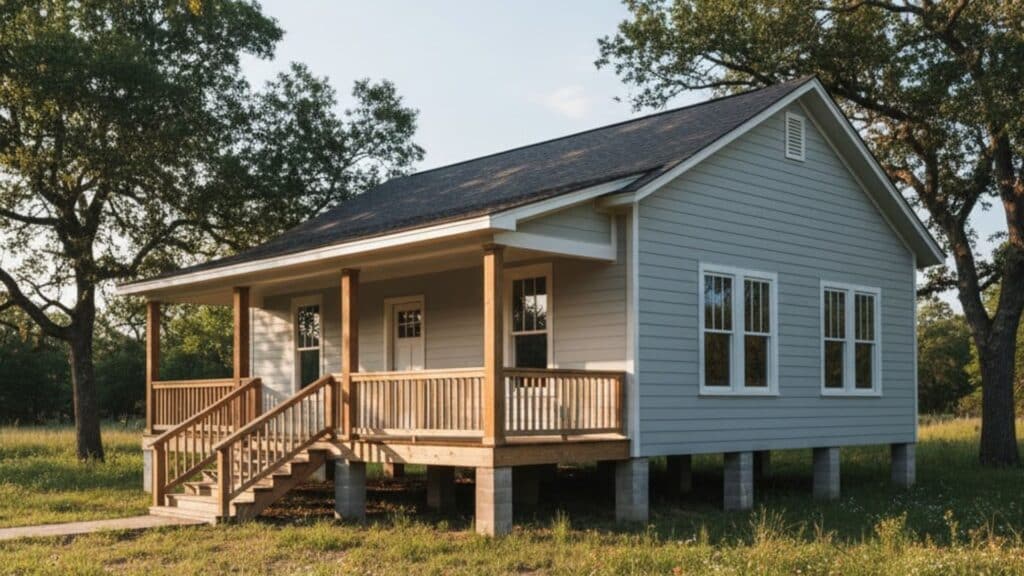What exactly is a pier and beam house, and why does it matter for your home? I know foundation types can feel confusing when you’re buying, building, or renovating your property.
A pier and beam house sits raised above the ground on posts and beams instead of concrete slabs. This unique foundation style offers specific advantages depending on where you live and your soil type.
Understanding how this foundation works helps you make smarter decisions about maintenance, repairs, and home purchases. You’ll know exactly what to look for and how to care for your investment properly.
I’ll explain everything about pier and beam houses in simple terms that anyone can understand easily. Get ready to become confident about your home’s foundation like never before.
What Is a Pier and Beam House?
A pier and beam house is a home built on a foundation that raises it above the ground. This type of foundation uses vertical support posts called piers that hold up horizontal beams underneath the structure.
The piers sit directly on the ground or concrete footings and carry the weight of your entire house. Beams run across the tops of these piers and support the floor joists that hold up your floors.
Between the ground and your home’s floor sits an open area called a crawl space. This space typically measures one and three feet in height. Piers and beams can be made from concrete, treated wood, or steel, depending on the location.
How a Pier and Beam Foundation Works?

A pier and beam foundation works by distributing your home’s weight evenly across multiple support points. The floor joists transfer the load down to the beams that sit horizontally across the piers.
These piers then carry all that weight straight down into the soil beneath your house. The weight spreads out through the soil, creating a stable base that keeps your home level.
The crawl space underneath plays several important roles beyond just providing structural support. It gives easy access to plumbing pipes, electrical wiring, and HVAC ducts whenever repairs are needed.
Air circulates freely through this space, helping prevent moisture buildup that causes mold and wood rot problems.
Pier and Beam vs. Slab Foundations
Understanding the differences between pier and beam and slab foundations helps you make informed decisions about your home. Here’s a detailed comparison of how these two foundation types stack up:
| Feature | Pier and Beam | Slab Foundation |
|---|---|---|
| Structure | Elevated foundation with crawl space underneath | Concrete poured directly on the ground |
| Repair Access | Easy access through the crawl space | Difficult, requires breaking concrete |
| Moisture Control | Better ventilation reduces moisture problems | Can trap moisture without proper barriers |
| Climate Suitability | Works well in areas with expansive soil | Better for stable soil and dry climates |
| Energy Efficiency | May need extra insulation in the crawl space | Better insulation from ground contact |
| Pest Control | Requires regular crawl space monitoring | Less vulnerable to pest intrusion |
Each foundation type has unique advantages depending on your location and soil conditions. Choose the option that best fits your budget, climate, and long-term maintenance preferences.
How to Identify a Pier and Beam House?

Knowing how to spot a pier and beam house helps you understand how your home is built. These homes have a unique foundation that you can see and feel:
Exterior Signs
Look outside your home to find clues; it might be a pier and beam. These physical indicators are easy to spot:
- The house is raised several feet above the ground, creating space underneath.
- Foundation vents are visible along the sides of the home for crawlspace airflow.
- You may see small access doors or panels near the ground leading to the crawlspace.
- The base of the home often shows a clear frame or beams beneath the siding.
These signs help you quickly identify the foundation without needing any tools. Look for these key features when walking around your house.
Interior Signs
Inside, the structure feels different from slab foundations. Pay attention to how the home behaves underfoot:
- The floors feel a little springy or bouncy when you walk on them.
- You might find easy access to plumbing or wiring under floorboards or in crawl space areas.
- Look for floorboards that have slight gaps or move a little as you walk.
- Doors and cabinets close differently and might stick or feel uneven if the foundation shifts.
Noticing these signs helps you understand the foundation type, especially during home maintenance or inspection.
Pros and Cons of Pier and Beam Houses
Every foundation type comes with its own set of benefits and drawbacks you should understand. Here’s what you need to know about pier and beam foundations:
| Advantages | Disadvantages |
|---|---|
| Easier access for repairs through the crawl space | Moisture, rot, and pest issues in crawl space |
| Works well on uneven or flood-prone land | Uneven floors or sagging beams over time |
| Less prone to cracking than slab foundations | Higher heating costs in cold climates |
| Good ventilation under the home reduces moisture | Requires regular crawl space maintenance |
Weighing these pros and cons helps you decide if this foundation type suits your needs. Your climate, soil conditions, and maintenance commitment all play important roles in making the right choice.
Maintenance and Repair Tips
Regular maintenance keeps your pier and beam foundation strong and prevents costly repairs down the road. Here are essential care tips every homeowner should follow:
- Keep your crawl space dry and well-ventilated by installing vents and checking for standing water regularly.
- Inspect all wooden components annually for signs of rot, termite damage, or structural weakness that needs attention.
- Maintain your gutters and drainage systems to direct water away from your foundation and prevent moisture problems.
- Add insulation or vapor barriers in your crawl space if you notice moisture buildup or high energy bills.
- Regularly check pier alignment and moisture levels to catch shifting or settling issues before they become serious.
Following these maintenance practices extends your foundation’s lifespan and protects your home’s structural integrity. A little preventive care now saves you thousands in major repair costs later on.
Cost and Lifespan
The average cost to build or repair a pier and beam foundation in 2025 ranges widely based on project size and location.
Building a 2,000-square-foot pier and beam home can cost around $20,000 to $30,000. Repair costs vary from a few thousand dollars for small fixes to over $20,000 for major repairs.
With good upkeep, these foundations can last 50 to 75 years. Compared to slab foundations, pier and beam repairs often cost less because they allow easier access and targeted fixes.
Slab repairs tend to be more expensive and invasive. Proper maintenance extends a pier and beam foundation’s lifespan, saving money over time.
These costs are estimated and may vary based on your location, material quality, brand preferences, and current market prices.
When Pier and Beam Houses Make Sense
Pier and beam foundations work best in specific situations where other foundation types might fail or cost more. They’re perfect for sloped land where leveling the ground for a slab would be too expensive.
Homes in flood-prone areas benefit greatly from the elevation that pier and beam foundations naturally provide. The raised structure keeps your living space above potential water damage during heavy rains or flooding events.
This foundation type excels in areas with expansive clay soil that shrinks and swells with moisture changes.
Older homes undergoing restoration often use pier and beam foundations to maintain their historical authenticity and character throughout the process.
Wrapping It Up
Now you understand what a pier and beam house is and how it differs from slab foundations. This knowledge helps you make informed choices about buying, maintaining, or repairing your home’s foundation system.
Your foundation type affects everything, including repair costs, energy efficiency, and how long your house lasts. Knowing these details puts you in control of your property’s future and helps prevent expensive surprises later.
Remember that regular inspections and proper maintenance keep your pier and beam foundation strong for decades.
If you currently own a pier and beam house or plan to buy one soon matters. Share your foundation experiences or ask specific questions in the comments below!














